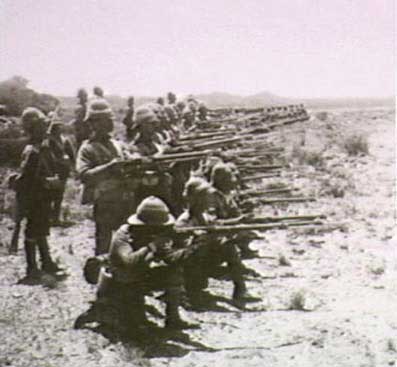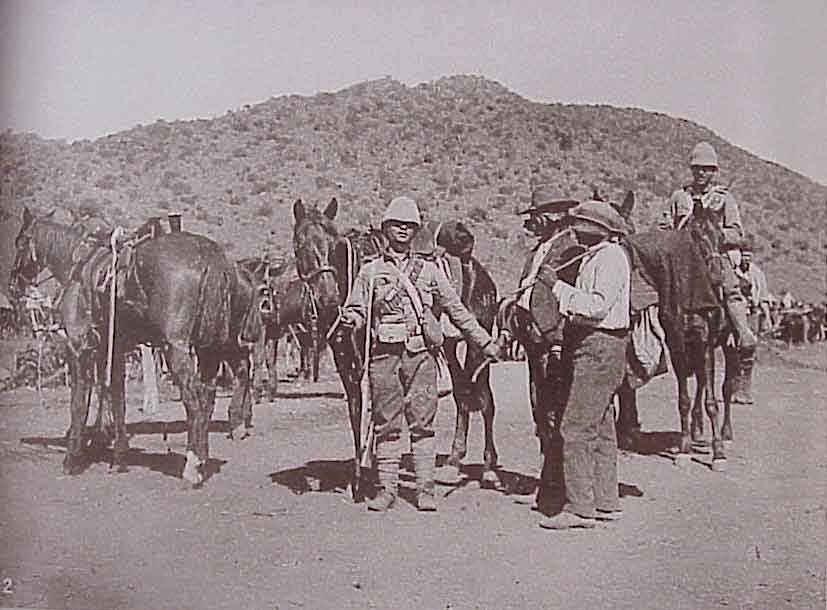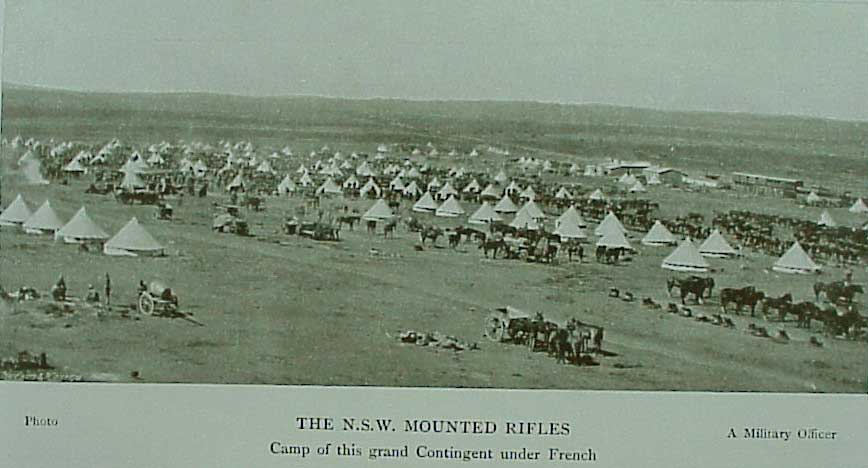
Soldiers of Colonel Porter with bayonets ready practising to meet a Boer Cavalry charge,
Naauwpoort 13 December 1900
Back to home Back to Historical
The
Van Rensburg's of Rensburg Siding, Colesberg, Cape part
1
The Anglo-Boer War Introduction
part 2
The Anglo-Boer War around
Rensburg Siding: Boer Leaders part 3
The Anglo-Boer War around
Rensburg Siding Nov 1899 part
4
The Anglo-Boer
War around Rensburg Siding Dec 1899 part
5
The
Anglo-Boer War around Rensburg Siding Jan 1900 part
6
The Anglo-Boer War around
Rensburg Siding Feb 1900 part 7
The
Anglo-Boer War in retrospect part
8
Australian units, persons and casualties part
9
MAIN
MAP source http://www.mjvn.co.za/anglo-boer/mainmap1.jpg
The Anglo-Boer War: Australians capture De Wet's artillery gun at Rensburgdrift part 10
Page 1 Page 2
The
Anglo-Boer War around Rensburg Siding
December
1899
By the end of December 1899 the Boers had unwillingly retreated to the northern
kopjes (hills). This enabled the British forces to occupy the outer
range of the of kopjes on the west side of Colesberg. The result of
these actions were that the Boers feared being cut off by the British. A further
problem was the burghers low morale under the leadership of Schoeman.
Realizing the danger Colesberg was in, Schoeman asked Commandant Naude to telegraph
for reinforcements. Naude reported that "the big hill" very near the
town had been captured by the enemy who had up to 35 guns shelling them from
all sides. He gives his casualties as 5 killed and 9 wounded. General Grobler
also telegraphed from the Colesberg Bridge for reinforcements.
Schoeman, sent the following telegram to President Steyn of the Orange Free
State:
"De vyand komt nu in groot getallen aan, ik schat hen soo wat 3000 sterk
en ook met wagens. Zy hebben reeds 6 kanonnen in positie geplaatst en treinen
zyn reeds by Rensburg Siding aangekomen zoodat ik elk oogenblik een aanval verwacht.
Is er kans op hulp? " [The enemy are now arriving in large numbers, I estimate
about 3000 strong accompanied with wagons. They already have 6 field guns in
position and their forces have arrived at Rensburg Siding. I expect an attack
at any moment. Is there a chance of getting assistance?]
The requested reinforcements arrived promptly. De la Rey was sent to Colesberg,
but before he reached the town, the ZARPS under Van Dam crossed the Orange River
on 1st January 1900. Piet de Wet, who's appointment to Colesberg was seen as
an attempt to assist and ginger up Schoeman, had arrived earlier. His headquarters
were on the farm Kuilfontein which already had been abandoned by Thomas
Plewman early in November 1899. The arrival of reinforcements enabled the Boers
to take full advantage of the natural cover.
The ZAR fighters consisted of commandos from Johannesburg, including the Johannesburg
Germansand the Krugersdorpers. This made it possible for the entrenchment of
several heavy guns on the southern side of the town.
During December Taaibochslaagte served as an emergency hospital for the Boers. This was at Rensburg Siding on the farm of Cornelis Johannes (John) van Rensburg.

Soldiers of
Colonel Porter with bayonets ready practising to meet a Boer Cavalry charge,
Naauwpoort 13 December 1900
On the 1st December 1899 the first English reinforcements, made up of 400 men of the New Zealand Mounted Rifles under the command of Major Robin, arrived at Naauwpoort.
By Wednesday the 5th December 1899 Colonel TC Porter arrived with a battalion of Suffolk's, the second half of the battalion of the Black Watch, three squadrons of the Carabiniers, R & O Batteries of Horse Artillery and two breech loading 15-pounders.
Two days later on 7th December 1899 Colonel Porter took up position on Inniskilling Hill near Rietfontein Farm.
On 8th December General French forced Schoeman out of Arundel and on the next day French took Arundel under his control.

Native prisoners being brought blindfolded to Arundel
The
Australian journalist Banjo Paterson wrote from Arundel (this would have been
on the farm Rietfontein of Nicolaas Albertus Jansen van Rensburg) on
9 December 1899:
"This is written from a Boer homestead. The owner has been arrested as
a sympathiser with the enemy. I have got the use of his stable for my horses.
It is absurdily like an Australian homestead in every way - sheep-yards, horse-yards,
cultivation and docks - everything reminded one of Australia. There is a spring
here of lovely water and a grand garden. The troops keep great discipline. The
crops are untouched in the fields [this changed dramatically later in the war],
the sheep go out with their shepherd through the middle camp. One can buy milk
at 6d a pint, and forage - very good hay - at 6d a bundle. The boy who speaks
a little English - a small little chap of about 14 - is the head of the family
while his father is away [this must have been Nicolaas Albertus born 10 Oct
1884.] He says the kaffirs won't do any work. They sit down and play all day
long, and the cows are frightened of the troops, and keep coming up the yard
to see what the matter is". Source: R.W.F. Droogleever
(ed), From the Front: A.B. (Banjo) Paterson's Dispatches from the Boer War,
p. 42.
Banjo mentions that when he got to Naauwpoort on 7th December, Captain Cox who commanded the NSW Lancers with a little over 40 men, were already there and they did a lot of patrols.
On 11th December 1899 Colonel Porter mounted a successful attack on Vaalkop. The Boers at Vaalkop suffered one casualty and three wounded in a small battle with the 10th Hussors.
Banjo
wrote on 11th December:
"We saw a little white farmhouse [must have been the farm Vaalkop
of Andries van Rensburg] with a round kopje at the back. There was nothing about
the farmhouse to show it was occupied. ... Suddenly, when we were about a mile
off, a swarm of men ran out of the cottage, jumped over a low wall, and then
re-appeared on horseback, their horses being tied up behind the house. Our cavalry
swung round from left to right, a gun was wheeled round, the artillerymen jumped
to their places, and before the Boers could cover the quarter mile of ground
that separated them from the kopje, bang went the cannon. One of the horsemen
went down, and the rest rode wildly for shelter". From the Front: A.B.
(Banjo) Paterson's Dispatches from the Boer War, p. 46.
Around December 12 a rumour was spread that a big English force was advancing to take Colesberg, this rumour may have been spread by French. The result was that the hesitant Schoeman went defensive and therefore did not pursue an offensive strategy at all. Oorlogsdagboek van Jan F. E. Celliers 1899 - 1902, p. 43n.
On 13th December 1899 Colonel Fisher advanced to Maeder's Farm, benig the same day on which Arundel Siding was attacked.
On 14 December, after visiting the farm Jasfontein of veldkornet Geldenhuys, one of the English were shot by some Boers. Robbin and the New Zealanders went back on the 18 December and bombarded the farm.
.
New Zealand
Mounted Rifles at Rensburg 15 January 1900
On
16th December 1899, moving out from Kuilfontein, Piet de Wet attacked Vaalkop.
As a result the Boer forces of General Schoeman and Piet de Wet caused the English
force under the command of RJ Thudway to retreat from Vaalkop (near
Rensburg Siding). This led to a lot of preparation by both sides for a major
confrontation. During this time General Schoeman sent instruction to commandant
Preller to immediately send 20 boxes of artillery shells to Rensburg Siding,
since they did not have enough ammunition to continue with the battle.
Oorlogsdagboek van Jan F. E. Celliers 1899 - 1902, p. 47n;
Albert Grundlingh, Die "Hendsoppers" en "Joiners",
p. 296.
Banjo
wrote:
"Our men and the New Zealanders with their sloach hats and free-and-easy
appearance are constantly being mistaken for Boers, and it will be lucky if
some of them are not shot by their own side before the war is over". From
the Front: A.B. (Banjo) Paterson's Dispatches from the Boer War, p. 59.
"At the farmhouse where we are camped there is a procession of soldiers all day long with mugs wanting to buy milk, and if they liked to advance their price they could sell all their milk at half-a-crown a pint, as the regiment is full of wealthy men, who would give anything for fresh milk, especially when they get sick; but no, those people look on the price of milk as 3d a bottle, and they sell all they have at 3d a bottle." From the Front: A.B. (Banjo) Paterson's Dispatches from the Boer War, p. 65.
French
moved to Arundel in person on 17 December and made his headquarters there. The
New Zealander's went on a patrol to Jasfontein and the Boer's had to
retreat.

The NSW Mounted
Rifles at most likely Arundel Station
On 18th December 1899 Field-Marshal Lord Roberts was appointed to succeed Buller as Supreme Commander with Lord Kitchener as his Chief of Staff. On the same day General French, accompanied Major AH Robin, (commanding the New Zealand Mounted Rifles and a battery of Horse Artillery) and attacked the Boers stationed on the farm Jasfontein.